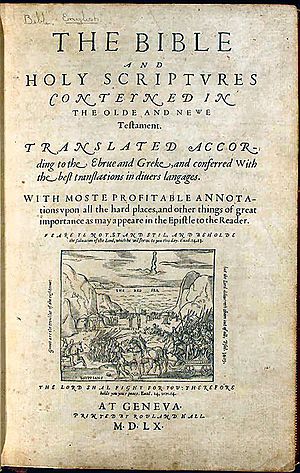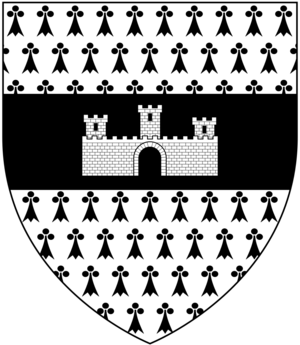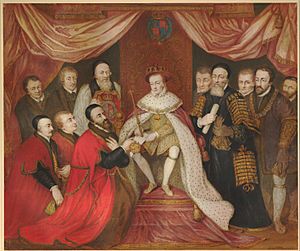Rowland Hill (MP) facts for kids
Quick facts for kids
Sir Rowland Hill of Soulton
|
|
|---|---|
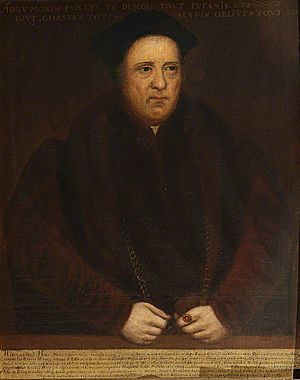
Portrait of Sir Rowland Hill of Soulton
|
|
| Publisher of the Geneva Bible, Lord Mayor of London, Member of the Privy Council, Member of Parliament, Sheriff of the City of London, Member of the Council of Wales and the Marches, Master of the Worshipful Company of Mercers, | |
| Lord Mayor of London | |
| In office 1549–1549 |
|
| Monarch | Edward VI |
| Preceded by | Sir Henry Amcotes |
| Succeeded by | Sir Andrew Judde |
| Sheriff of London | |
| In office 1542–1542 |
|
| Monarch | Henry VIII |
| Personal details | |
| Born | ?1498 Hodnet, Shropshire |
| Died | 28 or 29 October 1561 London |
| Resting place | St Stephen Walbrook, London 51°30′45.46″N 0°5′23.71″W / 51.5126278°N 0.0899194°W |
| Relations | Viscount Hill Sir Rowland Hill |
Sir Rowland Hill (around 1495–1561) was a very important person in Tudor England. He was known as "The First Protestant Lord Mayor of London" because he held that job in 1549. He also published the famous Geneva Bible.
Sir Rowland Hill was a smart and active person. He was a statesman, a merchant, and someone who supported arts and charities. He lived through the reigns of four different monarchs: Henry VIII, Edward VI, Mary I, and Elizabeth I. Some people even think his life might have inspired characters in William Shakespeare's plays!
Contents
Early Life and Beginnings

Rowland Hill was born in a town called Hodnet in Shropshire, England, around 1495. He was the oldest son of Thomas Hill and Margaret Wilbraham. He had one younger brother, William, and four sisters.
When he was young, Rowland became an apprentice to a London merchant named Thomas Kitson. An apprentice learns a trade by working for an experienced person. By 1519, he became a full member of the Mercers' Company, which was a powerful group of merchants.
He was very active in the Mercers' Company, serving as a warden several times.
Publishing Important Books
The Geneva Bible
Sir Rowland Hill was closely involved in publishing the 1560 Geneva Bible. This was a huge achievement! It was the first Bible to be printed using a machine.
This Bible was very popular and important. Many famous people used it, including William Shakespeare, Oliver Cromwell, and John Knox. It was also one of the Bibles that traveled to America on the Mayflower ship. Queen Elizabeth I even gave permission for it to be printed in England. Over 140 different versions of the Geneva Bible were made during the 84 years it was published.
Other Books He Published
Besides the Bible, Hill published 26 other books between 1559 and 1562. These books covered many different and interesting topics. They included books about strategy games, government, religion, new lands, and medicine.
Some of the books he published were:
- The Whole and True Discovery of Terra Florida (1563)
- The most ancient and learned Playe, called the Philosopher's Game (1562)
- The Lawes and Statutes of Geneva (1562)
- Certaine vvorkes of chirurgerie (1562)
- The Boke of Psalmes (1559)
- Aeneid 1–10. Translated by Thomas Phaer. (1562)
Interestingly, some of his published works had a special symbol: a half eagle and a key. This same symbol appears on the front page of an early edition of Shakespeare's play, A Midsummer Night's Dream.
Connections to Early Theatre
Hill was involved in bringing back the "Marching Watch" or "Mid Summer Watches" in London. These were big parades where thousands of citizens dressed in bright clothes and gold chains marched through the city. King Henry VIII himself watched these parades from Mercers Hall.
Sir Rowland Hill was also friends with Thomas Lodge. Some people believe that a character named Rowland de Bois in Shakespeare's play As You Like It might have been inspired by Sir Rowland Hill. His home, Soulton Hall, may even have been thought of as a kind of theatre.
Important Public Roles
In 1541–42, Rowland Hill was chosen as a sheriff for the City of London. During this time, he was briefly held in the Tower of London because of a disagreement with Parliament. However, King Henry VIII later showed him favor by making him a knight in May 1542.
In November 1549, Hill became the Lord Mayor of London. This was a time of big religious changes in England. As Mayor, he helped guide London through some of these important shifts towards Protestantism.
He was a close friend of Sir Thomas Bromley, a powerful statesman. People said that Hill was a "good minister of justice" during his time as Lord Mayor. He worked hard to stop bad behavior in the city.
When Queen Mary came to the throne, Hill was one of London's representatives in Parliament. Even though he was seen as a Protestant, he managed to keep a role in public life. He was even appointed as a judge in important trials.
After Queen Elizabeth I became queen, Hill helped put into action new laws that supported the Protestant Church. It's quite amazing that Hill was given the job of seizing forbidden books under both Protestant and Catholic rulers!
Charitable Work
Sir Rowland Hill was known for his kindness and charity. In 1555, he started a school in Market Drayton in Shropshire. He also played a big part in setting up hospitals in London. He was the first president of Bridewell and Bethlehem Hospitals and helped manage London's hospitals until he died.
Some of his charitable actions included:
- Building a new stone bridge and two timber bridges in Atcham.
- Giving clothes to 300 poor people every year.
- Repairing the church in Stoke.
- Giving money to the poor in London.
He also supported schools and helped establish early job centers and poverty relief programs. He helped many students go to Oxford and Cambridge Universities.
Buildings and Memorials
Sir Rowland Hill was also involved in building. His home, Soulton Hall, is thought to have special hidden meanings in its design.
When he died on October 28, 1561, he was buried at St Stephen Walbrook church in London. It is said that he forgave his tenants a year's rent before he passed away. A statue of him was placed in the church, showing him holding the Magna Carta.
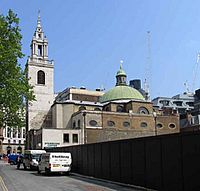
There is also a bust (a sculpture of his head and shoulders) of him at the school he founded in Market Drayton. Another statue of him stands on a pillar in Hawkstone Park in Shropshire. This statue shows him looking towards Soulton Hall and holding a copy of the Magna Carta.
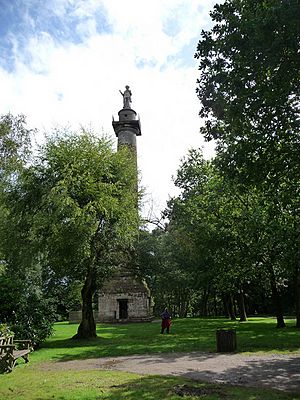
Family and Legacy
Sir Rowland Hill's wife died during his time as Lord Mayor, and they did not have children. So, his property went to his brother and the children of his four sisters.
One of his relatives was Alice Baker, who married Sir Thomas Leigh. Their descendants include important figures like the Dukes of Marlborough and the Dukes of Leeds.
A charity named after Sir Rowland Hill is still helping people today.
Portraits
There are several 16th-century paintings of Sir Rowland Hill. You can find them in the Museum of London, at the Mercers' Hall, and at places like Attingham Park and Tatton Park.


